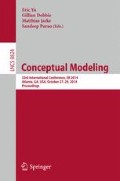Abstract
The environments in which businesses currently operate are dynamic and constantly changing, with influence from external and internal factors. When businesses evolve, leading to changes in business objectives, it is hard to determine and visualize what direct Information System responses are needed to respond to these changes. This paper introduces an enterprise architecture framework which allows for anticipating and supporting proactively, adaptation in enterprise architectures as and when the business evolves. This adaptive framework exploits and models relationships between business objectives of important stakeholders, decisions related to these objectives, and Information Systems that support these decisions. This framework exploits goal modeling in a Business Intelligence context. The tool-supported framework was assessed against different levels and types of changes in a real enterprise architecture of a Canadian government department, with encouraging results.
Access this chapter
Tax calculation will be finalised at checkout
Purchases are for personal use only
Preview
Unable to display preview. Download preview PDF.
References
Akhigbe, O.S.: Business Intelligence - Enabled Adaptive Enterprise Architecture. M.Sc. thesis, Systems Science, University of Ottawa (2014), http://hdl.handle.net/10393/31012
Amyot, D., Yan, J.B.: Flexible Verification of User-Defined Semantic Constraints in Modelling Tools. In: CASCON 2008, pp. 81–95. ACM Press (2008)
Amyot, D., Ghanavati, S., Horkoff, J., Mussbacher, G., Peyton, L., Yu, E.: Evaluating Goal Models within the Goal-oriented Requirement Language. Int. J. Intell. Syst. 25(8), 841–877 (2010)
Amyot, D., Mussbacher, G.: User Requirements Notation: The First Ten Years, The Next Ten Years. Journal of Software 6(5), 747–768 (2011)
Amyot, D., Shamsaei, A., Kealey, J., Tremblay, E., Miga, A., Mussbacher, G., Alhaj, M., Tawhid, R., Braun, E., Cartwright, N.: Towards Advanced Goal Model Analysis with jUCMNav. In: Amyot, D., et al. (eds.) ER 2012 Workshops 2012. LNCS, vol. 7518, pp. 201–210. Springer, Heidelberg (2012)
Cardoso, E.C.S.: Challenges in Performance Analysis in Enterprise Architectures. In: 17th IEEE Int. EDOC Conference Workshops, pp. 327–326. IEEE CS (2013)
Cretu, L.G. (ed.): Designing Enterprise Architecture Frameworks: Integrating Business Processes with IT Infrastructure. Apple Academic Press (2014)
DeLone, W., McLean, E.: Information Systems Success Revisited. In: Proc. 35th Annual Hawaii International Conf. (HICSS 2002), vol. 8, pp. 2966–2976. IEEE CS (2002)
Gill, A.: The Gill Framework: Adaptive Enterprise Architecture Toolkit. Create Space Independent Publishing Platform (2012)
Hoogervorst, J.: Enterprise Architecture: Enabling Integration, Agility and Change. International Journal of Cooperative Information Systems 13, 213–233 (2004)
Horkoff, J., Barone, D., Jiang, L., Yu, E., Amyot, D., Borgida, A., Mylopoulos, J.: Strategic Business Modeling: Representation and Reasoning. Software & Systems Modeling 13(3), 1015–1041 (2012)
International Telecommunication Union: Recommendation Z.151, User Requirements Notation (URN) – Language Definition (October 2012)
ISO/IEC/IEEE 42010 Systems and Software Engineering - Architecture Description, 1st edn. (2011)
Kassab, M.: An integrated approach of AHP and NFRs framework. In: Seventh Int. Conf. on Research Challenges in Information Science (RCIS), pp. 1–8. IEEE CS (2013)
Kast, F.E., Rosenzweig, J.E.: Organization and Management: A Systems and Contingency Approach. McGraw-Hill (1985)
Laudon, K.C., Laudon, J.P.: Essentials of management information systems: Managing the digital firm. Prentice Hall (2005)
Liaskos, S., Jalman, R., Aranda, J.: On eliciting contribution measures in goal models. In: 20th Int. Requirements Engineering Conference, pp. 221–230. IEEE CS (2012)
Luftman, J., Brier, T.: Achieving and Sustaining Business-IT Alignment. California Management Review 42(1), 109–122 (1999)
Nalchigar, S., Yu, E.: From Business Intelligence Insights to Actions: A Methodology for Closing the Sense-and-Respond Loop in the Adaptive Enterprise. In: Grabis, J., Kirikova, M. (eds.) PoEM 2013. LNBIP, vol. 165, pp. 114–128. Springer, Heidelberg (2013)
Najafi, E., Baraani, A.: An Adaptive Enterprise Architecture Framework. In: Int. Summit and Conf. on Enterprises *as* Systems. Hoffman Estates, IL (2010)
Nash, K.S.: CIOs in Search of IT Simplicity. CIO (June 2012), http://bit.ly/1yZVbYT (retrieved January 24, 2013)
Pourshahid, A., Chen, P., Amyot, D., Forster, A.J., Ghanavati, S., Peyton, L., Weiss, M.: Business Process Management with the User Requirements Notation. Electronic Commerce Research 9(4), 269–316 (2009)
Prakash, N., Gosain, A.: An approach to engineering the requirements of data warehouses. Requirements Engineering 13(1), 49–72 (2008)
Saaty, T.L.: How to Make a Decision: The Analytic Hierarchy Process. European Journal of Operational Research 48(1), 9–26 (1990)
Sessions, R.: A Comparison of the Top Four Enterprise Architecture Methodologies. Microsoft (2007), http://msdn.microsoft.com/en-us/library/bb466232.aspx
Singh, S.N., Woo, C.: Investigating business-IT alignment through multi-disciplinary goal concepts. Requirements Engineering 14(3), 177–207 (2009)
Warmer, J., Kleppe, A.: The Object Constraint Language: Getting Your Models Ready for MDA, 2nd edn. Addison-Wesley, Boston (2003)
Weiss, M., Amyot, D.: Business Process Modeling with URN. IJEBR 1(3), 63–90 (2005)
Wilkinson, M.: Designing an ‘Adaptive’ Enterprise Architecture. BT Technology Journal 24(4), 81–92 (2006)
Yu, E., Deng, S., Sasmal, D.: Enterprise Architecture for the Adaptive Enterprise - A Vision Paper. In: Aier, S., Ekstedt, M., Matthes, F., Proper, E., Sanz, J.L. (eds.) TEAR 2012 and PRET 2012. LNBIP, vol. 131, pp. 146–161. Springer, Heidelberg (2012)
Author information
Authors and Affiliations
Editor information
Editors and Affiliations
Rights and permissions
Copyright information
© 2014 Springer International Publishing Switzerland
About this paper
Cite this paper
Akhigbe, O., Amyot, D., Richards, G. (2014). A Framework for a Business Intelligence-Enabled Adaptive Enterprise Architecture. In: Yu, E., Dobbie, G., Jarke, M., Purao, S. (eds) Conceptual Modeling. ER 2014. Lecture Notes in Computer Science, vol 8824. Springer, Cham. https://doi.org/10.1007/978-3-319-12206-9_33
Download citation
DOI: https://doi.org/10.1007/978-3-319-12206-9_33
Publisher Name: Springer, Cham
Print ISBN: 978-3-319-12205-2
Online ISBN: 978-3-319-12206-9
eBook Packages: Computer ScienceComputer Science (R0)

